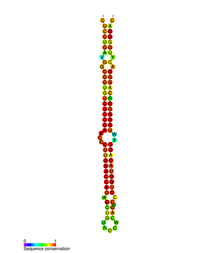- miR-150
-
miR-150 
Conserved secondary structure of miR-150 microRNA precursor Identifiers Symbol miR-150 Alt. Symbols MIR150 Rfam RF00767 miRBase MI0000479 miRBase family MIPF0000197 Entrez 406942 HUGO 31537 OMIM 610566 RefSeq NR_029703 Other data RNA type miRNA Domain(s) Mammalia GO 0035195 SO 0001244 Locus Chr. 19 q13.33 miR-150 is a family of microRNA precursors found in mammals, including humans. The ~22 nucleotide mature miRNA sequence is excised from the precusor hairpin by the enzyme Dicer.[1] This sequence then associates with RISC which effects RNA interference.[2]
miR-150 functions in hematopoiesis; it regulates genes whose downstream products encourage differentiating stem cells towards becoming megakaryocytes rather than erythrocytes.[3] It is also thought to control B and T cell differentiation, alongside mir-155.[4][5]
Expression
The expression pattern of miR-150 varies during the differentiation of a hematopoietic stem cell lineage. Highest expression levels occur in mature, resting B and T cells but miR-150 is downregulated in their progenitor cells, including Th1 and Th2 cells.[4]
Role in cancer
miR-150 has been linked with a number of cancers. It is thought to promote cancer cell proliferation in gastric cancer and has also been found to be more than 50x overexpressed in osteosarcoma.[6] In malignant lymphoma, however, miR-150 is significantly downregulated in tumour cells relative to healthy cells.[7]
Applications
miR-150 levels in blood plasma can be indicative of early sepsis; it could have a future use therapeutically in treating the condition.[8] In addition, miR-150 is one of a number of microRNAs whose expression profile could be used as a biomarker of hepatocellular carcinoma.[9]
References
- ^ Ambros, V (2001 Dec 28). "microRNAs: tiny regulators with great potential.". Cell 107 (7): 823–6. PMID 11779458.
- ^ Gregory, RI; Chendrimada, TP, Cooch, N, Shiekhattar, R (2005 Nov 18). "Human RISC couples microRNA biogenesis and posttranscriptional gene silencing.". Cell 123 (4): 631–40. PMID 16271387.
- ^ Edelstein, LC; Bray, PF (2011 May 19). "MicroRNAs in platelet production and activation.". Blood 117 (20): 5289–96. PMID 21364189.
- ^ a b Vasilatou, D; Papageorgiou, S, Pappa, V, Papageorgiou, E, Dervenoulas, J (2010 Jan 1). "The role of microRNAs in normal and malignant hematopoiesis.". European journal of haematology 84 (1): 1–16. PMID 19744129.
- ^ Garzon, R; Croce, CM (2008 Jul). "MicroRNAs in normal and malignant hematopoiesis.". Current opinion in hematology 15 (4): 352–8. PMID 18536574.
- ^ Lulla, RR; Costa, FF, Bischof, JM, Chou, PM, de F Bonaldo, M, Vanin, EF, Soares, MB (2011). "Identification of Differentially Expressed MicroRNAs in Osteosarcoma.". Sarcoma 2011: 732690. PMID 21789031.
- ^ Watanabe, A; Tagawa, H, Yamashita, J, Teshima, K, Nara, M, Iwamoto, K, Kume, M, Kameoka, Y, Takahashi, N, Nakagawa, T, Shimizu, N, Sawada, K (2011 Aug). "The role of microRNA-150 as a tumor suppressor in malignant lymphoma.". Leukemia : official journal of the Leukemia Society of America, Leukemia Research Fund, U.K 25 (8): 1324–34. PMID 21502955.
- ^ Vasilescu, C; Rossi, S, Shimizu, M, Tudor, S, Veronese, A, Ferracin, M, Nicoloso, MS, Barbarotto, E, Popa, M, Stanciulea, O, Fernandez, MH, Tulbure, D, Bueso-Ramos, CE, Negrini, M, Calin, GA (2009 Oct 12). "MicroRNA fingerprints identify miR-150 as a plasma prognostic marker in patients with sepsis.". PloS one 4 (10): e7405. PMID 19823581.
- ^ Magrelli, A; Azzalin, G, Salvatore, M, Viganotti, M, Tosto, F, Colombo, T, Devito, R, Di Masi, A, Antoccia, A, Lorenzetti, S, Maranghi, F, Mantovani, A, Tanzarella, C, Macino, G, Taruscio, D (2009 Aug 18). "Altered microRNA Expression Patterns in Hepatoblastoma Patients.". Translational oncology 2 (3): 157–63. PMID 19701500.
Further reading
- Tsitsiou, E; Lindsay, MA (2009 Aug). "microRNAs and the immune response.". Current opinion in pharmacology 9 (4): 514–20. PMID 19525145.
miRNA precursor families 1-100 101-200 201+ Other Categories:- Genes on chromosome 19
- MicroRNA
Wikimedia Foundation. 2010.
